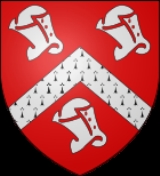
Tudor dynasty
Overview
The Tudor dynasty or House of Tudor was a European royal house
of Welsh
origin that ruled the Kingdom of England
and its realms, including the Lordship of Ireland
, later the Kingdom of Ireland
, from 1485 until 1603. Its first monarch was Henry Tudor
, a descendant through his mother of a legitimised branch of the English royal House of Lancaster
. The Tudor family rose to power in the wake of the Wars of the Roses
, which left the House of Lancaster, to which the Tudors were aligned, extinct.
Henry Tudor was able to establish himself as a candidate not only of the traditional Lancastrian supporters, but of discontented supporters of the rival House of York
, and rose to capture the throne in battle, becoming Henry VII
.
Royal House
A royal house or royal dynasty consists of at least one, but usually more monarchs who are related to one another, as well as their non-reigning descendants and spouses. Monarchs of the same realm who are not related to one another are usually deemed to belong to different houses, and each house is...
of Welsh
Welsh people
The Welsh people are an ethnic group and nation associated with Wales and the Welsh language.John Davies argues that the origin of the "Welsh nation" can be traced to the late 4th and early 5th centuries, following the Roman departure from Britain, although Brythonic Celtic languages seem to have...
origin that ruled the Kingdom of England
Kingdom of England
The Kingdom of England was, from 927 to 1707, a sovereign state to the northwest of continental Europe. At its height, the Kingdom of England spanned the southern two-thirds of the island of Great Britain and several smaller outlying islands; what today comprises the legal jurisdiction of England...
and its realms, including the Lordship of Ireland
Lordship of Ireland
The Lordship of Ireland refers to that part of Ireland that was under the rule of the king of England, styled Lord of Ireland, between 1177 and 1541. It was created in the wake of the Norman invasion of Ireland in 1169–71 and was succeeded by the Kingdom of Ireland...
, later the Kingdom of Ireland
Kingdom of Ireland
The Kingdom of Ireland refers to the country of Ireland in the period between the proclamation of Henry VIII as King of Ireland by the Crown of Ireland Act 1542 and the Act of Union in 1800. It replaced the Lordship of Ireland, which had been created in 1171...
, from 1485 until 1603. Its first monarch was Henry Tudor
Henry VII of England
Henry VII was King of England and Lord of Ireland from his seizing the crown on 22 August 1485 until his death on 21 April 1509, as the first monarch of the House of Tudor....
, a descendant through his mother of a legitimised branch of the English royal House of Lancaster
House of Lancaster
The House of Lancaster was a branch of the royal House of Plantagenet. It was one of the opposing factions involved in the Wars of the Roses, an intermittent civil war which affected England and Wales during the 15th century...
. The Tudor family rose to power in the wake of the Wars of the Roses
Wars of the Roses
The Wars of the Roses were a series of dynastic civil wars for the throne of England fought between supporters of two rival branches of the royal House of Plantagenet: the houses of Lancaster and York...
, which left the House of Lancaster, to which the Tudors were aligned, extinct.
Henry Tudor was able to establish himself as a candidate not only of the traditional Lancastrian supporters, but of discontented supporters of the rival House of York
House of York
The House of York was a branch of the English royal House of Plantagenet, three members of which became English kings in the late 15th century. The House of York was descended in the paternal line from Edmund of Langley, 1st Duke of York, the fourth surviving son of Edward III, but also represented...
, and rose to capture the throne in battle, becoming Henry VII
Henry VII of England
Henry VII was King of England and Lord of Ireland from his seizing the crown on 22 August 1485 until his death on 21 April 1509, as the first monarch of the House of Tudor....
.
Unanswered Questions

